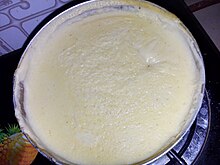Ogi (food)
 | |
| Alternative names | Akamu |
|---|---|
| Type | Pap or pudding |
| Place of origin | Nigeria |
| Region or state | West Africa |
| Main ingredients | Maize, sorghum or millet |
| Ingredients generally used | sugar |
| Variations | Uji in Kenya |

Ogi (or Akamu) is a fermented cereal pudding and popular street food from Nigeria, typically made from maize, sorghum, or millet.[1][2][3][4] Traditionally, the grains are soaked in water for up to three days, before wet-milling or grinding and sieving to remove husks. The filtered cereal is then allowed to ferment for up to three days until sour. It is then boiled into a pap, or cooked to make a creamy pudding also known as Agidi or Eko.[5] It may be eaten with moin moin, acarajé or bread depending on individual choice.
In Kenya the porridge is known as uji (not to be confused with ugali) and is generally made with millet and sorghum. It is commonly served for breakfast and dinner,[6][7][8] but often has a thinner gravy-like consistency.[9]
The fermentation of ogi is performed by various lactic acid bacteria including Lactobacillus spp and various yeasts including Saccharomyces and Candida spp.[1][10][11]
See also
- Boza - Fermented grain drink
- Fermentation in food processing
- List of African dishes
- Mageu - African fermented beverage
- Poi - Starchy Polynesian dish that is sometimes fermented
- Pozol - Fermented corn drink from the Americas
- Komfot Pap - Pap manufacturer in Nigeria
References
- ^ a b "Fermented Cereals - A Global Perspective". United Nations FAO. Retrieved 2006-07-22.
- ^ "Process of making Ogi (pap, akamu)". Vanguard News. 2017-04-26. Retrieved 2022-06-01.
- ^ Kenzap (2020-07-14). "AKAMU/OGI (PAP)". Diet Tech Africa. Retrieved 2022-06-01.
- ^ "Oloye Corn Meal - Akamu / Pap / Koko/ogi". My Sasun. Retrieved 2022-06-01.
- ^ "Ogi (pap)". Divine Foods Store Incorporated. Retrieved 2022-06-01.
- ^ "Lavidalocavora". Archived from the original on 2014-12-30. Retrieved 2015-01-08.
- ^ "UJI | Meaning & Definition for UK English | Lexico.com". Lexico Dictionaries | English. Archived from the original on June 1, 2022. Retrieved 2022-06-01.
- ^ Ekpa, Onu; Palacios-Rojas, Natalia; Kruseman, Gideon; Fogliano, Vincenzo; Linnemann, Anita R. (2019-10-03). "Sub-Saharan African Maize-Based Foods - Processing Practices, Challenges and Opportunities". Food Reviews International. 35 (7): 609–639. doi:10.1080/87559129.2019.1588290. ISSN 8755-9129. S2CID 155197863.
- ^ "Bella online".
- ^ Nago, Mathurin Coffi; Hounhouigan, Joseph D.; Akissoe, Noël; Zanou, Elisabeth; Mestres, Christian (June 1998). "Characterization of the Beninese traditional ogi, a fermented maize slurry: physicochemical and microbiological aspects". International Journal of Food Science & Technology. 33 (3): 307–315. doi:10.1046/j.1365-2621.1998.00169.x.
- ^ Omemu, Adebukunola Mobolaji; Okafor, Uchechukwu Ifeoma; Obadina, Adewale O.; Bankole, Mobolaji O.; Adeyeye, Samuel Ayofemi Olalekan (July 2018). "Microbiological assessment of maize ogi cofermented with pigeon pea". Food Science & Nutrition. 6 (5): 1238–1253. doi:10.1002/fsn3.651. PMC 6060903. PMID 30065825.
